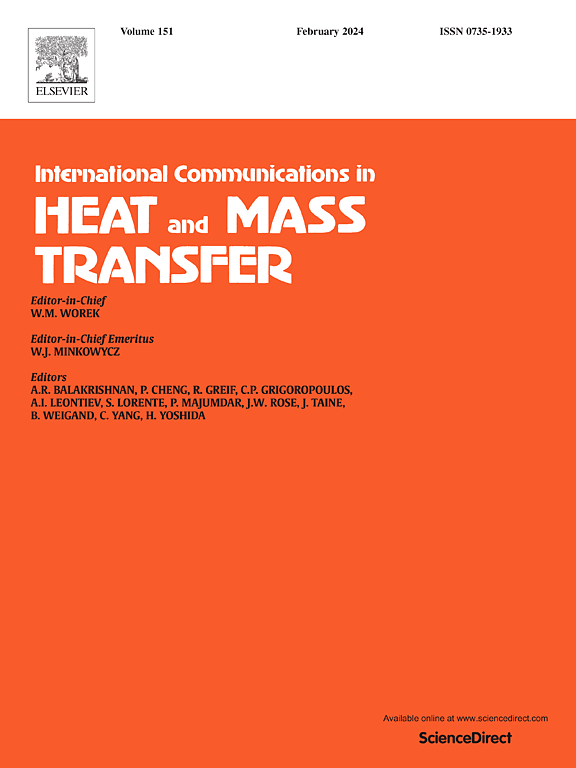AI-driven modeling of bioconvective nanofluid flow: An ANN approach to anisotropic slip and heat transfer in 3D systems
IF 6.4
2区 工程技术
Q1 MECHANICS
International Communications in Heat and Mass Transfer
Pub Date : 2025-05-14
DOI:10.1016/j.icheatmasstransfer.2025.109035
引用次数: 0
Abstract
Understanding the dynamics of nanofluids with microorganisms is crucial for biotechnology and thermal engineering applications, as they significantly influence heat and mass transfer processes. This study aims to analyze the behavior of nanofluids containing microorganisms over a three-dimensional moving surface, incorporating the effects of bioconvection, anisotropic slip, and convective boundary conditions. The governing equations are transformed into ordinary differential equations using similarity variables and solved numerically. Additionally, an Artificial Neural Network (ANN) is trained on numerical simulation data to develop a predictive model, enabling rapid and accurate predictions without the need for computational simulations. The results indicate that increasing the Prandtl number (Pr) from 3.2 to 6.2 leads to a 27.4 % reduction in the temperature profile (θ), while the concentration profile (φ) exhibits an inverse trend, increasing by 18.6 % within the boundary layer. Additionally, an increase in the Lewis number (Le) from 2 to 5 enhances thermal diffusivity, resulting in a 14.8 % increase in the thickness of the thermal boundary layer. The close agreement between numerical and ANN predictions validates the model's accuracy, demonstrating the effectiveness of machine learning in capturing complex fluid dynamics. These findings contribute to the optimization of heat and mass transfer processes in nanofluid applications, reducing computational costs while maintaining high precision.
人工智能驱动的生物对流纳米流体流动建模:三维系统中各向异性滑移和传热的人工神经网络方法
了解纳米流体与微生物的动力学对于生物技术和热工程应用至关重要,因为它们显著影响传热和传质过程。本研究旨在分析含微生物的纳米流体在三维移动表面上的行为,包括生物对流、各向异性滑移和对流边界条件的影响。利用相似变量将控制方程转化为常微分方程,并进行数值求解。此外,人工神经网络(ANN)在数值模拟数据上进行训练以开发预测模型,无需计算模拟即可实现快速准确的预测。结果表明,当Prandtl数(Pr)从3.2增加到6.2时,温度分布(θ)降低27.4%,而浓度分布(φ)在边界层内则呈现相反的趋势,增加18.6%。此外,当路易斯数(Le)从2增加到5时,热扩散率增加,导致热边界层厚度增加14.8%。数值和人工神经网络预测之间的密切一致验证了模型的准确性,证明了机器学习在捕获复杂流体动力学方面的有效性。这些发现有助于优化纳米流体应用中的传热传质过程,在保持高精度的同时降低计算成本。
本文章由计算机程序翻译,如有差异,请以英文原文为准。
求助全文
约1分钟内获得全文
求助全文
来源期刊
CiteScore
11.00
自引率
10.00%
发文量
648
审稿时长
32 days
期刊介绍:
International Communications in Heat and Mass Transfer serves as a world forum for the rapid dissemination of new ideas, new measurement techniques, preliminary findings of ongoing investigations, discussions, and criticisms in the field of heat and mass transfer. Two types of manuscript will be considered for publication: communications (short reports of new work or discussions of work which has already been published) and summaries (abstracts of reports, theses or manuscripts which are too long for publication in full). Together with its companion publication, International Journal of Heat and Mass Transfer, with which it shares the same Board of Editors, this journal is read by research workers and engineers throughout the world.

 求助内容:
求助内容: 应助结果提醒方式:
应助结果提醒方式:


